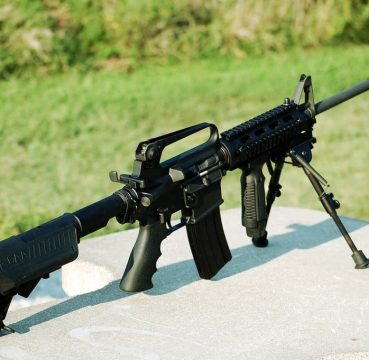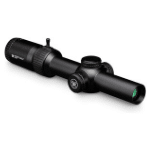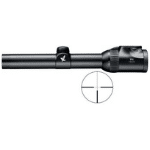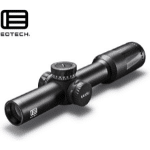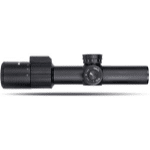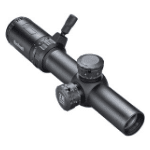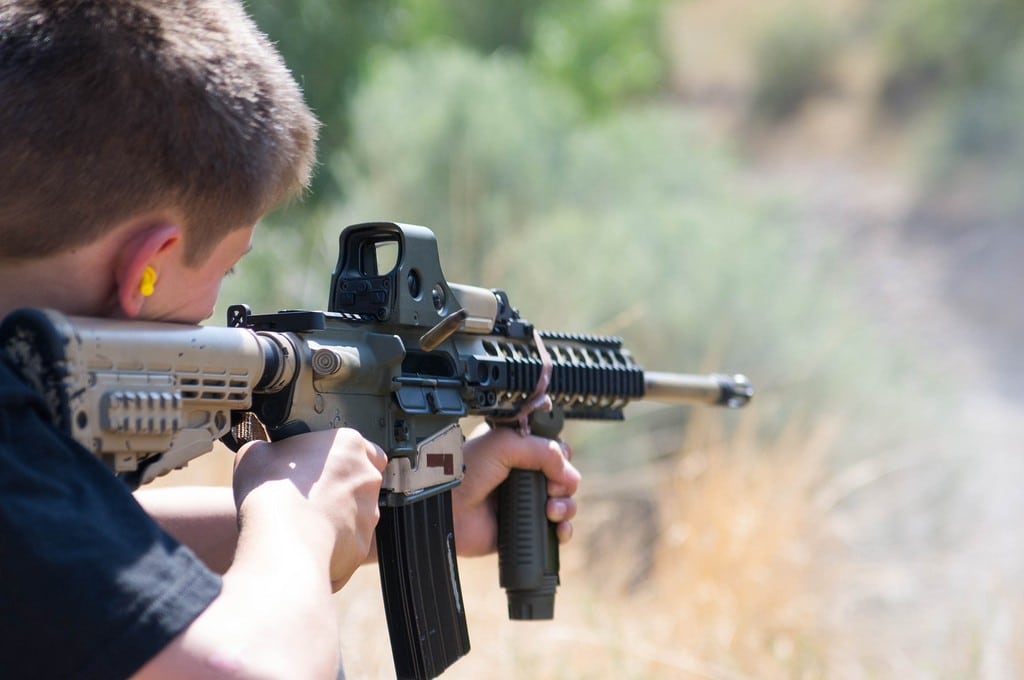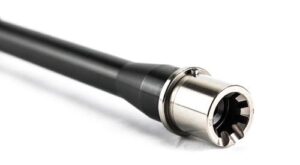No matter how long you’ve been training with your AR-15, it’s important to recognize that skill alone can only take you so far. If you’re really looking to max out your AR 15 accuracy, you need to start looking at how the rifle itself might be holding you back.
Fortunately, the AR-15’s famous modular design makes it well-suited to a variety of AR 15 upgrades, enhancements, and other modifications: all you need is some cash, some time, and a few basic tools.
In this article, we’ll discuss some of the mods that can help you turn your standard AR into a precision tool of pinpoint accuracy.
Table Of Contents
- 1. Improved AR 15 Optics
- AR 15 Variable Power Scopes
- AR 15 Red Dot Sights
- Prism Scopes
- 2. Better Ammunition
- 3. A New Trigger
- 4. Free Float Handguards
- 5. Improve Your AR 15 Barrel
- AR 15 Barrel Twist Rate
- AR 15 Gas System Measurements
- 6. Invest In AR 15 Stocks
- 7. Coil-Reduction Devices
- AR 15 Accuracy – Conclusion
- Recommended Reading
1. Improved AR 15 Optics
Human eyesight is impressive but still limited in a number of ways. That’s why the most important AR-15 accuracy investment you can make is purchasing a good, high-quality optic. This is key to helping you “aim small” and start popping off those bullseye shots from 200, 250, and 300 yards out.
Now, there is an optic solution for virtually every budget and shooting style. Of course, each has its benefits and drawbacks, which we’ll discuss in detail below.
AR 15 Variable Power Scopes
Those who are looking for versatility in their optic choice will love variable power scopes. Such scopes allow you to manually adjust the magnification as you move from shot to shot. When it comes to AR-15s, most shooters opt for a “Low-Power Variable Optic,” or LPVO.
These usually have a max magnification of around 4 to 10x. Of course, it’s also important to consider the focal plane of your scope, which will fall into one of two categories: FFP (First Focal Plane) and SFP (Second Focal Plane). With the former, the reticle will grow and shrink if you alter your magnification. This can help you compensate for bullet drop, as the marks on the reticle will remain accurate regardless of magnification.
An SFP keeps the reticle’s size the same, which gives you a more consistent view of the target. However, this also means that any bullet drop marks will only be accurate at full magnification. The main downside of variable power scopes is their weight, which can seem significant when strapped to an ultra-lightweight AR.
They can also be a bit on the pricy side, which will give some gun owners pause. However, it’s important that you know that these prices aren’t arbitrary. Glass quality is a big issue when it comes to performance, and pricier VPSs often feature premium glass to maximize long-distance accuracy.
AR 15 Red Dot Sights
These AR 15 sights have become among the most popular in the world, and for good reason. Red dots allow you to cover the target as fast as your eyes can react, regardless of how far your eye is from the glass. On top of that, they allow you to keep both of your eyes open in order to maintain your situational awareness.
Red dot sights (our top picks) are also super lightweight, which is why they’re preferred among military and law enforcement offices. These individuals are most likely to encounter firing situations of 0 to 100 yards, where fast, accurate shots would be most needed. Of course, red dots are not perfect.
For instance, gun owners who suffer from astigmatism may not see the dot clearly, which will drastically limit their accuracy at long range. There are magnifiers to assist with this problem, but that will also slow reaction time, as they’ll need to be adjusted every time the shot distance changes.
Prism Scopes
Prism scopes have been around for decades, and they boast a number of benefits that most gun owners tend to love. For instance, they provide fixed magnification while taking up a lot less space than a standard rifle scope. Many also offer an illuminated reticle similar to a red dot but that is actually etched into the glass itself.
This can be a benefit in situations where losing a red dot battery could mean life or death. Many prism scopes will include an adjustable diopter, which can solve issues related to astigmatism. Most AR owners find that prism scopes are a great balance between durability, capability, and weight.
Usually, you’ll get a fixed magnification of around 1x to 6x, which is more or less ideal for an AR’s range. They often give you a tone of reticle choices as well, so you can pretty much dial in your scope to your shooting style. Just remember that such scopes don’t offer fixed magnification, so they won’t be as versatile as other options.
2. Better Ammunition
What you shoot is nearly as important as how you shoot it. Remember, cheap ammo is cheap because the same amount of money isn’t invested in quality control and ballistic precision. This means that each round will often perform differently, which can drastically affect your AR 15 accuracy (especially at long range).
That said, if you spend $2 per round on the so-called “best ammo in the world,” you’re going to cut down your shooting time in order to save cash. This will eventually start to dig into your shooting abilities, which might render your investment useless. Ultimately, you should aim to have a diverse array of ammo at your disposal all the time.
This should include cheaper ammo for training and expensive ammo for competitions, hunting, and self-defense. For the latter, most AR owners prefer open tip match bullets, also known as OTMs. These are manufactured to be as uniform as possible and to maintain their shape when fired. This helps ensure that each round functions as closely as possible to the last.
3. A New Trigger
Veteran AR owners know just how important a good trigger is to their overall shooting experience. Indeed, those baseline Mil-Spec triggers can feel very inconsistent to some, especially when you start really considering accuracy. This is even more noticeable when you’re shooting quickly, as it’s not uncommon to miss a trigger reset and bungle a shot.
But a new trigger can provide a whole new experience. That said, you need to know what to look for in a trigger before you can evaluate what it is you want from it. We’ll discuss these aspects in detail below:
Pull Weight – This is how much force is required to trip the sear and send the hammer forward, firing the round. Most Mil-Spec triggers have a pull weight of roughly 5 lbs., but aftermarket triggers are usually much lighter. This makes it easier for the shooter to fire off rounds in quick succession without impacting accuracy.
Trigger Shoe – This is the part of the trigger that your finger actually comes in contact with. Some shooters prefer a curved or bowed design, while others prefer the feel of a straight shoe. You can argue over which is best all day, but it ultimately comes down to what you like best.
Trigger Stage – There are single-stage triggers and two-stage triggers The former requires a consistent amount of pressure to be applied before it breaks. The latter has a loose initial stage followed by a second stage with greater resistance. Breaking this secondary wall typically requires less pressure than a single-stage design would necessitate.
Single-stage triggers are very common in ARs. This is because they are often excellent for rapid-fire. That said, double-stage triggers give you a little bit more feel for when the trigger will break, which can contribute to accuracy in many cases. It’s up to you, but it’s important that you buy from a reputable trigger manufacturer when shopping for new triggers. Here are our top picks for AR 15 Triggers.
4. Free Float Handguards
Assume you’re up against a barricade. This stabilizes your rifle for the shot, therefore increasing accuracy, right? Not always. You see, pressing against a non-free float handguard when you’re up against a barricade can alter the point of impact ever so slightly. In fact, even the energy transfer needed to pull the trigger can push the barrel off target.
A free-float handguard can fix this problem. Put simply: this handguard only attaches to the upper receiver, which means the barrel is left floating in between. Though it might seem pointless at first, this is an ideal way to preserve what’s known as “barrel harmonics.” What your hand is doing (and what it’s pressed up against) will therefore have far less impact on your shot.
That said, this isn’t the easiest modification to make. You’ll need to take off your front sight, remove your delta right, and potentially remove your barrel nut, depending on the brand. If you’re unsure of how to do any of this, turn to an expert for help. Here are our top picks for AR 15 Handguards.
5. Improve Your AR 15 Barrel
I can tell you straight away that there’s nothing wrong with the stock barrel on your AR. However, that doesn’t mean you can’t improve upon it. So, if you’re starting to hit a plateau on the range, it might be time to consider an upgrade to improve your AR 15 accuracy. Of course, as with triggers, there’s a lot that goes into selecting a good barrel, such as:
Material and Production Process
Like firearms themselves, different barrels are all designed to perform different jobs. Some are intended to be more reliable and rugged, while others are specifically geared toward maximum precision. In the opinion of most experts, a stainless steel barrel is a way to go when you want to turn inches into centimeters on the firing range.
As this material is much softer, the rifling process can be done with greater precision during production. That said, this also means that these barrels will need to be replaced more often.
Barrel Length
Barrel length is important for a number of reasons, but accuracy is the primary one. Longer barrels tend to increase velocity, which can improve accuracy over long distances. That said, it’s worth noting that a poor quality barrel that’s 24 inches long won’t be any more accurate than a 14-inch barrel, so you need to consider the manufacturer’s reputation at all times.
In the opinion of this writer, a 16-inch barrel is your best bet for a 100-yard range. If you’re expecting to pop off more shots in the 300 range, an 18 to 20-inch barrel will put the bullet there much faster, and therefore with less drop.
AR 15 Barrel Twist Rate
Twist rates are something that tends to confuse a lot of shooters. However, it’s actually simpler than you think. In plain English, this describes how many inches of barrel is required for the rifling inside to rotate one full turn. For instance, a 1:8 twist means the bullet will turn one time every 8 inches, a 1:9 will turn every 9 inches, and so on. Now, what does this matter?
Well, faster twist rates like 1:8 and 1:7 are usually required to stabilize heavier bullets, such as your 70gr. However, slower twist rates are better for bullets in the 40 to 50gr range. If you want maximum performance, including in terms of accuracy, you need to match your ammo to your twist rate.
The most versatile options are 1:8s and 1:9s, but we’ve included a chart to make your selection as easy as possible.
| Reliable Bullet Weight | Twist Rate |
|---|---|
| 40gr | 1:12 |
| 55gr | 1:9 |
| 62gr | 1:8 or 1:7 |
| 77gr | 1:7 or 1:8 |
| 80gr | 1:7 |
AR 15 Gas System Measurements
Though frequently overlooked during discussions of accuracy, the best shooters know that a shorter gas tube will have a higher recoil. As you might expect, this can affect your second, third, and fourth shot quite dramatically. Since gas from the round being fired is recycled into the receiver to push the bolt carrier group back into place, shorter tubes increase the pressure of this action.
By contrast, a longer tube will reduce the pressure and reduce the overall recoil. Of course, you don’t want to extend the gas system to the point where it may prevent the BOG from resetting. The key is to find a middle ground between reliability and comfort.
6. Invest In AR 15 Stocks
Stocks are all about comfort, which leads many shooters to think of them as purely relating to ergonomics. However, your comfort can seriously impact your AR 15 accuracy and your ability to control the rifle. The goal should be to find a stock that offers a good cheek weld for maximum stabilization and a proper view through your optic.
You can select from collapsible stocks to fixed-length stocks to PDW stocks – it’s up to you. That said, most precision-focused shooters end up going with an adjustable rifle stock. Since you can adjust the length of pull, you get more versatility when you need it most. Here are our top picks for AR Stocks.
7. Coil-Reduction Devices
As we mentioned, AR-15s are well known for their ability to be modded. This has led to the development of a variety of muzzle devices designed to improve your recoil and AR 15 accuracy. One of the most popular options is the muzzle brake, which redirects expanding gasses from the barrel so that they help cancel out the forces caused by the exploding cartridge. This allows you to return to target much faster and helps smooth out the overall firing experience.
| Product Name | Where to Buy | |
|---|---|---|
 | A2 Birdcage |  |
 | Battlecomp 1.0 |  |
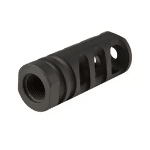 | Precision Armament M4-72 Severe Duty |  |
 | DPMS Miculek Compensator |  |
 | VG6 Gamma |  |
 | Strike Industries J-Comp V2 |  |
AR 15 Accuracy – Conclusion
In the end, the human element accounts for 90% of accuracy when shooting any firearm. So, if you’re neglecting the fundamentals, you can’t expect any of the options on this list to turn you into a bona fide tack pusher.
However, if you are already as good as you can get from a physical standpoint, these modifications may help you work on the remaining 10% of your accuracy pie chart.
Recommended Reading
Best AR-15 Calibers And Cartridges
How To Build an AR-15 Upper Receiver
